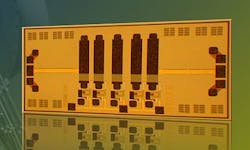RF and microwave filter chip for pre-selection in military radar and EW applications introduced by Hittite
CHELMSFORD, Mass., 11 July 2012. Hittite Microwave Corp. in Chelmsford, Mass., is introducing the HMC897 band pass tunable filter chip for pre-selection in advanced communications systems, military radar, electronic warfare (EW), satellite communications (SATCOM), space, industrial, and medical systems.
The varactor-tuned monolithic microwave integrated circuit (MMIC) filter is tunable over a 9 to 19 GHz frequency range, and is inherently stable for RF and microwave applications.
Its small physical size and insensitivity to environmental conditions make it a alternative to competing resonant cavity tuned filters and large switched filter banks, Hittite officials say.
The center frequency of the HMC897 band pass filter chip is adjustable from 9 GHz to 19 GHz by applying an analog tune voltage between 0 and 14 volts with a tuning speed of 200 nanoseconds.
The HMC897 exhibits microphonic immunity due to the monolithic design, and provides a dynamically adjustable solution for advanced communications applications. The HMC897 also provides a 3 dB filter bandwidth of about 18 percent, while the 20 dB filter bandwidth is about 35 percent.
Return loss is typically better than 10 dB across the operating frequency and wideband rejection is at least 30 dB out to 40 GHz. Residual phase noise is as low as -160 dBc/Hz at 100 KHz offset.
For applications that require a surface mount compatible solution, this same filter is available in a RoHS compliant 4-by-4-millimeter QFN SMT package as the HMC897LP4E.
Die samples, SMT product samples and evaluation PC boards for all SMT packaged products are available from stock and can be ordered via the company's e-commerce site or via direct purchase order.
For more information contact Hittite Microwave online at www.hittite.com.
Follow Military & Aerospace Electronics and Avionics Intelligence news updates on Twitter

